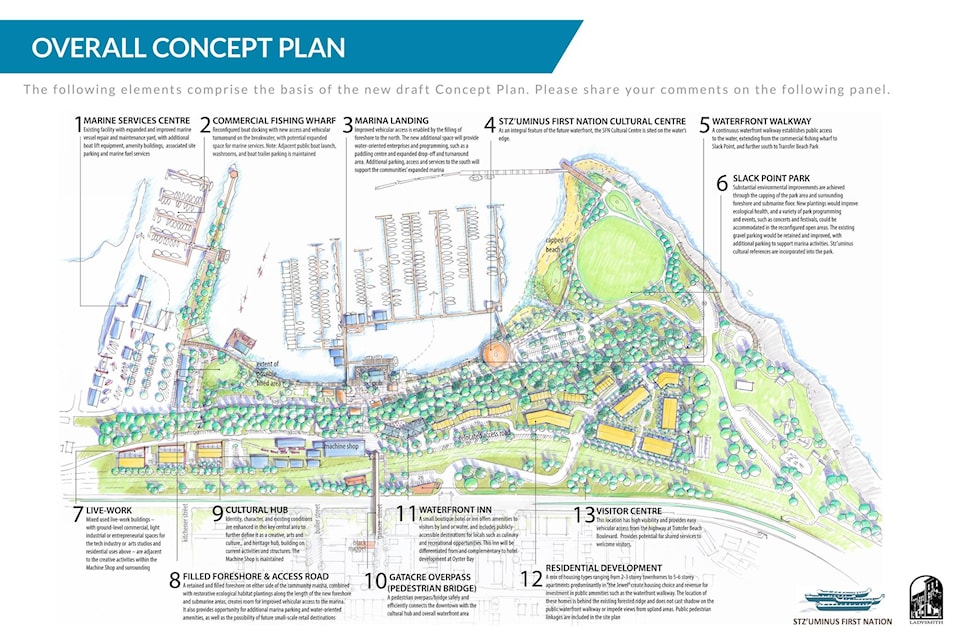Imagine looking out the window of a boutique hotel overlooking an expanded Ladysmith Community Marina.
Picture living right on the waterfront and taking a stroll down a boardwalk to a beautifully constructed Stz’uminus First Nation cultural centre.
Dream of a watching a concert at Slack Point just steps from a capped beach with new plantings improving the harbour’s ecological health.
It’s all wrapped up in a bold new vision for Ladysmith’s waterfront unveiled to the public last Wednesday at Aggie Hall following months of tireless work by community stakeholders, the town and its planning consultant team at Dialog.
While still in draft form, and more revisions likely still to come after meetings with stakeholder groups last week, the final version of the local area plan could come to city council as early as the fall.
“It’s meant to guide us for potentially a couple of decades but also gives us something that we can go to market with because there’s more detail and form and character than in your typical local area plan,” said Mayor Aaron Stone.
“People will look at the layout and think this looks beautiful but it’s not by accident. We looked at the work that was done in previous reports, where the contamination is, the seismic issues and those are addressed through this plan.”
Ladysmith has completed waterfront plans in the past but this process has been different, most importantly because of the partnership with Stz’uminus and the level of community engagement.
Dialog’s urban planner Jennifer Fix said the relationship between the two communities is both “exceptional” and “fairly unique” compared to other co-generative planning processes the firm has led.
“That relationship enabled a really special process,” she said. “That partnership is going to result in an outcome that is truly unique where there’s a sense of co-ownership and co-accountability for the success of the waterfront which you don’t find in a lot of other projects like this.”
To date, there have been 1,100 recorded interactions with community members and the survey that went live following an open house in February garnered 645 responses.
A 26-member design charrette team made up of stakeholders in the community also spent a weekend brainstorming ideas and sketching out plans.
“We tested the ideas using a design lens to make sure they were workable but in the end what you’re looking at is a reflection of what the community told us they aspire to see on the waterfront,” Fix added.
In the draft of the plan, Slack Point is proposed to be left in place and capped and there’s foreshore infill that would address waste issues while improving vehicle access to the marina.
Stone said there would be deeper conversations on these finer details once the town has a final plan that can be presented to the provincial and federal governments.
“We want to look at it as an environmental remediation plan that’s built on the pillars of economic sustainability,” he said.
The uses and design aspects of the plan are primarily geared towards locals, while still provinding elements that will attract visitors.
A relocated access road connecting to Transfer Beach Road could lead to a mix of two to three storey townhomes or apartments proposed to be no taller than six storeys.
Both would not impede the view from upland areas.
An area to the north could be zoned for live-work buildings with ground level commercial, such as light industrial, tech or entrepreneurial spaces and apartments upstairs.
“One of the key successful ingredients of this plan will be keeping the authentic working quality to the waterfront - that’s something you see in this plan and was successful in Granville Island,” Fix said.
Finally, a proposed pedestrian bridge over the Trans-Canada Highway, while likely to be costly, would link the Machine Shop to Gatacre Street and increase the walkability of the town.
“We think about impacts on downtown which is why connections are important,” Stone said. “Not too much commercial density on the waterfront other than uses that suit the it so you can say well there’s a whole other experience waiting to be enjoyed in a historic downtown.”
A new survey asking for feedback on the draft is available on the town’s website until July 31.
